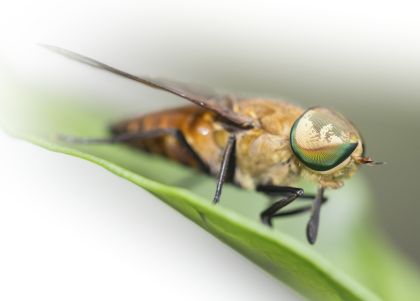Over-engineered odour detectors
Fruit flies’ ability to sniff out explosives explodes evolution myth

Over-engineering in nature is a problem for evolution. There are numerous examples already known of this—creatures which have been ‘over-equipped’ for environments they have never faced or which don’t exist naturally anywhere on Earth.
For example, tardigrades1 can survive being subjected to extreme laboratory treatments (radiation, cold temperature, hydrostatic pressure) far more severe than any Earth environment. As an evolutionist observed, “With such an arsenal of adaptations for survival, tardigrades appear to be over-engineered.”2
Similarly, the bacterium Deinococcus radiodurans can survive 12 million rads of gamma radiation, whereas natural radiation on Earth is nowhere more than a small fraction of that. “It is certainly a mystery how this trait has developed and why it persists,” said one evolutionary biologist, dismissing desperate suggestions from fellow evolutionists that it arose elsewhere in the solar system.3
The problem for defenders of evolution, according to their own theory, is that an organism will possess only the attributes it needs to survive. That’s all that natural selection can select for! So when organisms are discovered to have supra-optimal design, it bewilders evolutionists.
The latest example is the fruit fly, Drosophila melanogaster—specifically, the ability of its odour receptors to detect unfamiliar chemicals in drugs and explosives. The evolutionary researchers who discovered this wrote, “Drosophila receptors appear surprisingly capable of distinguishing chemicals that they have not evolved to process.”4
Furthermore, lead researcher Professor Thomas Nowotny of the UK’s University of Sussex said that, again “contrary to our expectation”, unfamiliar odours “were not only recognised but broadly recognised with the same accuracy as odours more relevant to a fly’s behaviour.”5
This accuracy is particularly attractive to the research engineers, who aim to build robots capable of mimicking6 the odour receptors of creatures such as these fruit flies, and sniffer dogs7 (currently used in policing of drugs and explosives):
The long-term goal of this research direction is to ‘re-create’ animals’ noses for technical applications.8
Notice: “recreate”. That word implicitly points to the originals having been themselves created—anathema to the evolutionary fraternity, which is perhaps why the word was in ‘scare quotes’. And also note that the research engineers’ recreated versions of the fruit fly’s or dogs’ sniffing apparatus will fall way short of the masterful engineering evident in God’s originals. Professor Nowotny explained:
“But it would be quite difficult to recreate the entire nose; even adopting all sensors would be too difficult. One may be able to do five or maybe 10, out of 43 in the fruit fly or hundreds in the dog. So the question is, which 10 should we use and would it work? In this paper we show that it could work with as little as 10 fruit fly receptors and we identify the most likely candidates to use.”5
Indeed, if just ten receptors are sufficient, why would you bother over-engineering with more? Perhaps one reason God over-engineered His creations was so that “we would never forget” just how all-powerful our omniscient, eternal Creator really is.
References and notes
- See: Catchpoole, D., Life at the extremes, Creation 24(1):40–44, 2001; creation.com/extreme. Return to text.
- Copley, J., Indestructible, New Scientist 164(2209):45–46, 1999. Return to text.
- Clark, S., Tough Earth bug may be from Mars, newscientist.com, 25 September 2002. Return to text.
- Nowotny, T., and four others, Drosophila olfactory receptors as classifiers for volatiles from disparate real world applications, Bioinspiration and Biomimetics 9:046007, 2014 | doi:10.1088/1748-3182/9/4/046007. Return to text.
- Hakner, J., How the fruit fly could help us sniff out drugs and bombs, sussex.ac.uk, 21 October 2014. Return to text.
- The design and construction of robots inspired by design in nature is a rapidly-expanding discipline known as biomimetics. See e.g. creation.com/biomimetics and creation.com/burgess. Return to text.
- For our earlier articles about sniffer dogs and olfactory detection, see creation.com/sniff1, ~/sniff2, and ~/smell. Return to text.
- Iacurci, J., Fruit flies could sniff out bombs, drugs, natureworldnews.com, 15 October 2014. Return to text.






Readers’ comments
Comments are automatically closed 14 days after publication.